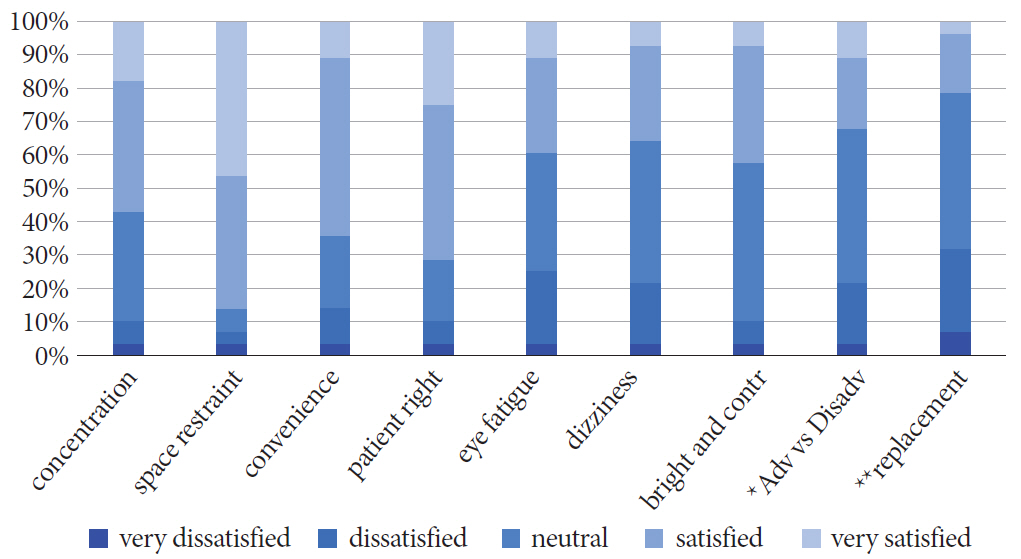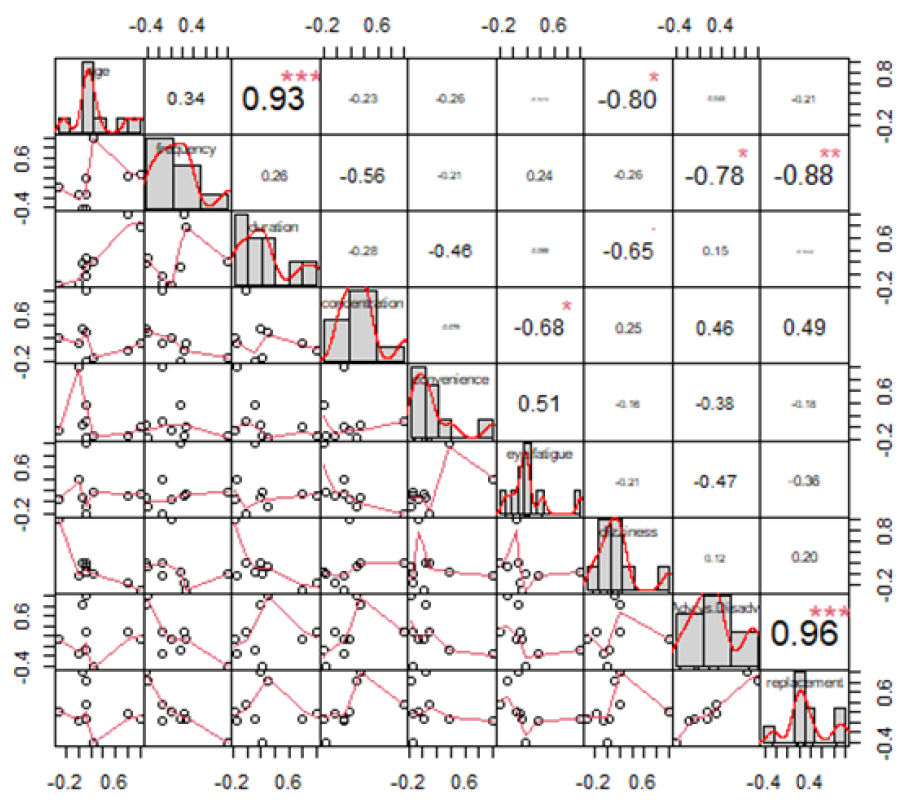Clin Endosc.
2021 Sep;54(5):694-700. 10.5946/ce.2020.246.
Feasibility of Wearable Display Glasses for Medical Students in the Endoscopy Room
- Affiliations
-
- 1Division of Gastroenterology and Hepatology, Department of Internal Medicine, and Institute of Gastrointestinal Medical Instrument Research, Korea University College of Medicine, Seoul, Korea
- KMID: 2520552
- DOI: http://doi.org/10.5946/ce.2020.246
Abstract
- Background/Aims
Several attempts have been made to incorporate smart glasses in the medical field. We applied wearable display glasses to show the position of an observer during endoscopy and compared students’ responses between the conventional and new methods.
Methods
We surveyed 28 medical students regarding the use of wearable display devices. The students used wearable display glasses to observe an endoscopic procedure and answered the prepared questionnaire. Their collected responses were analyzed for statistical correlations between each variable.
Results
The survey of medical students revealed disadvantages including dizziness (dissatisfied and very dissatisfied: 21.5%) and eye fatigue (25% dissatisfied) and advantages including concentration (satisfied and very satisfied: 57.2%) and securing patient rights (71.4%). The students showed more positive than negative reviews regarding the new devices (32.1% vs. 21.5%).
Conclusions
We investigated the advantages and disadvantages of viewing the endoscope image with new wearable display glasses compared to the conventional method using the survey to record user experience. The results revealed relatively positive responses from the medical students in the survey. If the new device compensates for some shortcomings, its use in the endoscopy room will be feasible.
Figure
Reference
-
1. Glauser W. Doctors among early adopters of Google Glass. CMAJ. 2013; 185:1385.
Article2. Muensterer OJ, Lacher M, Zoeller C, Bronstein M, Kübler J. Google Glass in pediatric surgery: an exploratory study. Int J Surg. 2014; 12:281–289.
Article3. Davis CR, Rosenfield LK. Looking at plastic surgery through Google Glass: part 1. systematic review of Google Glass evidence and the first plastic surgical procedures. Plast Reconstr Surg. 2015; 135:918–928.4. Wong BJ-F, Lee JP, Dugan FM, MacArthur CJ. Head-mounted display for use in functional endoscopic sinus surgery. In : PHOTONICS WEST ‘; 1995 Feb 1-28; San Jose (CA), USA. Bellingham (WA): SPIE;1995. p. 337.
Article5. van Lindert EJ, Grotenhuis JA, Beems T. The use of a head-mounted display for visualization in neuroendoscopy. Comput Aided Surg. 2004; 9:251–256.
Article6. Sebajang H, Trudeau P, Dougall A, Hegge S, McKinley C, Anvari M. Telementoring: an important enabling tool for the community surgeon. Surg Innov. 2005; 12:327–331.
Article7. Hashimoto DA, Phitayakorn R, Fernandez-del Castillo C, Meireles O. A blinded assessment of video quality in wearable technology for telementoring in open surgery: the Google Glass experience. Surg Endosc. 2016; 30:372–378.
Article8. Lee GI, Lee MR, Green I, Allaf M, Marohn MR. Surgeons’ physical discomfort and symptoms during robotic surgery: a comprehensive ergonomic survey study. Surg Endosc. 2017; 31:1697–1706.
Article9. Schlussel AT, Maykel JA. Ergonomics and musculoskeletal health of the surgeon. Clin Colon Rectal Surg. 2019; 32:424–434.
Article10. Peden RG, Mercer R, Tatham AJ. The use of head-mounted display eyeglasses for teaching surgical skills: a prospective randomised study. Int J Surg. 2016; 34:169–173.
Article11. Kim N, Jang ES, Park SM, Lee J-C. Work-life conflict and its health effects on Korean gastroenterologists according to age and gender. Gastroenterology. 2019; 156(6 Suppl 1):S–961.12. Malpas PJ, Bagg W, Yielder J, Merry AF. Medical students, sensitive examinations and patient consent: a qualitative review. N Z Med J. 2018; 131:29–37.13. Wanderley MDS, Sobral DT, Lima BAO, et al. Attitudes and personal attributes regarding patient receptivity towards the participation of medical students in gynecological consultations: a cross-sectional study. Rev Bras Ginecol Obstet. 2019; 41:613–620.
Article14. Morisawa T, Kida H, Kusumi F, Okinaga S, Ohana M. Endoscopic submucosal dissection using head-mounted display. Gastroenterology. 2015; 149:290–291.e1.
Article15. Yoshida T, Inoue H, Iwai T. A new face-mounted display system: pilot trial of clinical application in therapeutic endoscopy. Endoscopy. 2000; 32:974–976.
Article16. Liu CH, Lin SH, Pan YC, Lin YH. Smartphone gaming and frequent use pattern associated with smartphone addiction. Medicine (Baltimore). 2016; 95:e4068.
Article17. Lee LS, Carr-Locke DL, Ookubo R, Saltzman JR. Randomized trial of a video headset vs. a conventional video monitor during colonoscopy. Gastrointest Endosc. 2005; 61:301–306.
Article
- Full Text Links
- Actions
-
Cited
- CITED
-
- Close
- Share
- Similar articles
-
- Use of smart glasses for ultrasound-guided peripheral venous access: a randomized controlled pilot study
- Medical students’ self-assessed efficacy and satisfaction with training on endotracheal intubation and central venous catheterization with smart glasses in Taiwan: a non-equivalent control-group pre- and post-test study
- The Effect of Using Head Mounted Display on Human Eyes
- A Study on Stress of the Nursing Student in Delivery Room Practice
- A survey of the Refractive State of Elementary School Children in Rural Area





